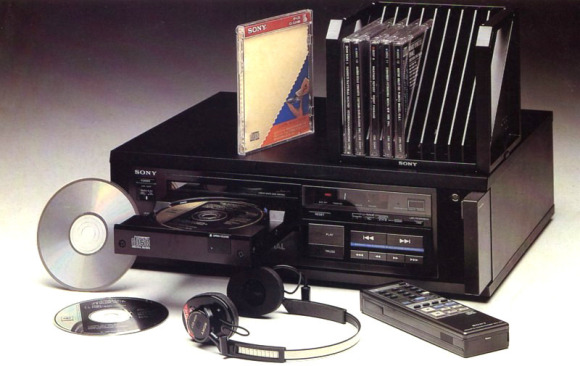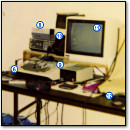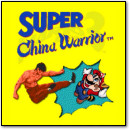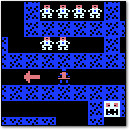[ VC&G Anthology ] A Detailed Timeline of Compact Disc Technology (2012)
November 8th, 2015 by Benj Edwards
10 DAYS OF VINTAGE: Day 7
When I write articles about the history of technology — which, I’ll admit, is fairly often — a few readers will sometimes say, “The author is obviously too young to remember X or Y,” or “He forgot to include X.” Sure, I don’t know everything. But most of the time, if there is ever an omission of something notable in one of my articles, a) I know about it, and b) it was done for a good reason.
(That reason, by the way, is usually brevity — editors almost always trim things out to make the article shorter. The second most common reason is that the omitted info, while generally understood to be true, is actually false.)
 When the occasion warrants it, and if time allows, I do the most exhaustive research I can manage on a topic. While browsing through my old writing files recently, I came across a fairly vivid illustration of this: a very detailed timeline of CD technology that I created while writing an feature about the 30th anniversary of the CD Player for TechHive back in 2012.
When the occasion warrants it, and if time allows, I do the most exhaustive research I can manage on a topic. While browsing through my old writing files recently, I came across a fairly vivid illustration of this: a very detailed timeline of CD technology that I created while writing an feature about the 30th anniversary of the CD Player for TechHive back in 2012.
During that process, I set out to understand the history of the CD Player and the Compact Disc medium as much as possible so I could explain it with confidence. One of the best ways to do that — to cover 30+ years of history and get it all straight — is to make a timeline. So that’s what I did.
The published article on TechHive includes key selections from this timeline at the bottom, but not everything. With the hope that my more detailed CD timeline might some day help future researchers, I am publishing it below, complete with sources when available.
This kind of thing makes me wonder how many other man-hours of journalistic research lay just out of reach because there is no proper context in which to share it. In this case, I’m lucky to have the VC&G Anthology series.

| Timeline of Compact Disc Technology by Benj Edwards (09/27/2012) |
|||||
| Year | Month | Day | Event | Source 1 | Source 2 |
| 1960 | 5 | 16 | Theodore Maiman creates the first functional laser at the Hughes Research Laboratory in California. | link | |
| 1962 | 3 | 21 | David Paul Gregg of Minnesota Mining and Manufacturing Company files a patent for a method to record and play a video disc. His designs store an analog video signal with an electron beam. | link | link |
| 1965 | James T. Russell, a researcher at the Pacific Northwest National Laboratory, comes up with the idea of optically encoded digital music. He later receives several patents related to his inventions. | ||||
| 1969 | Klaas Compaan, a Dutch physicist working at Philips, begins brainstorming an optical video disc that can be mass produced with a mold. | link | |||
| 1969 | David Paul Gregg sells his video disc patents to Philips. | link | link | ||
| 1972 | Philips and MCA demonstrate the Video Long Play (VLP) optical video disc to the press. This analog format is the precursor to LaserDisc. | New Scientist Sep 21, 1972, p.486 | link | ||
| 1974 | Researchers at Philips begin work on an Audio Long Play (ALP) disc, a digital audio follow-up to the VLP that would later become the Compact Disc. | link | |||
| 1977 | Sony, Mitsubishi, and Hitachi demonstrate optical digital audio disc prototypes at the Tokyo Audio Fair. | ||||
| 1978 | 12 | 15 | The first LaserDisc (initially known as “LaserVision”) players and discs reach the market. LaserDisc is an analog video format stored on 30 cm diameter optical discs. | link | link |
| 1978 | Digital Audio Disc Convention Held in Tokyo. 35 manufacturers attend. Philips proposes creation of worldwide CD standard. | ||||
| 1979 | 3 | 8 | Philips unveils a prototype 115 mm compact disc and its player during a press event in Holland. | Billboard Mar 24, 1979, p.3: link | |
| 1979 | 8 | 28 | Sony and Philips agree to change the CD diameter to 120mm so 74 minutes of 16-bit stereo audio sampled at 44.1 kHz can fit on a single disc. | link | |
| 1980 | 6 | Sony and Philips announce “Red Book” compact disc standard that defines the audio CD. | link | ||
| 1981 | Peter Doodson of Philips Design in the Netherlands heads up a team that designs a commercial enclosure for the CD — the jewel case. | link | |||
| 1982 | 8 | 17 | First ever commercial CD pressed: ABBA’s The Visitors. Manufactured in Germany. Not released until later. | link | |
| 1982 | 10 | 1 | The first 50 commercial CDs go on sale in Japan. Mix of classical, jazz, and Japanese and American pop music. Billy Joel’s 52nd Street, commonly cited as the first CD release, is among them. | link | link |
| 1982 | 10 | 1 | First commercial CD player, Sony CDP-101, released in Japan. Retails for 168,000 yen (about $674 at 1982 exchange rates, or $1,609 in 2012 dollars). | link | link |
| 1983 | 3 | CD players arrive in Europe with the release of the Philips CD 100. | link | ||
| 1983 | 3 | 2 | Sony and Philips introduce the first CD players to the US market. 16 CDs from RCA launch alongside. | link | |
| 1983 | Sony and Philips announce “Yellow Book” CD standard that defines basic CD-ROM structure, which defines how CDs can store computer data. | link | |||
| 1984 | 9 | CBS opens the first CD manufacturing plant in the US (in Terre Haute, Indiana). | link | ||
| 1984 | 11 | Sony introduces the first CD players for automobiles, the CDX-5 ($599.95 list price) and CDX-R7 ($699.95). The CDX-R7 integrates an AM/FM radio tuner. | link | Release Date: Billboard Oct 13, 1984, p.72: link | |
| 1984 | 11 | Sony releases the first portable CD player, the CD-5. It retails for $299.95. | Release Date: Billboard Oct 13, 1984, p.72: link | Popular Science Mar 1985, p.103: link | |
| 1984 | 11 | Sony, Philips, and other companies demonstrate the first prototype CD-ROM drives at COMDEX in Las Vegas. | Computerworld Nov 26, 1984, p.40: link | ||
| 1985 | 5 | Digital Equipment Corporation announces a line of databases on CD-ROM. 12 databases will be produced in 1985 before DEC abandons the program in July 1986. | InfoWorld Jul 1, 1985, p.18:link | InfoWorld Jul 28, 1986. p.11: link | |
| 1985 | 7 | Digital Equipment Corporation begins shipping its first CD-ROM drive. The $2,195 device hooks to MicroVAX I and II minicomputers. | InfoWorld Jul 1, 1985, p.18:link | ||
| 1985 | Spring | Sony produces CDU-1 prototype CD-ROM drive and provides it to universities and corporations for testing. | link | link | |
| 1985 | During 1985, various publishers make over 50 databases available in CD-ROM format for corporate, university, and library customers. Examples include MEDLINE database and an electronic version of the King James Bible. | US Black Engineer (Autumn 1986): link | |||
| 1985 | Dire Straits’ “Brothers in Arms,” released this year. It will later become the first CD to sell 1 million copies. | link | |||
| 1985 | Comedy troupe Firesign Theatre’s album “Eat or Be Eaten” is the first commercial CD to contain subcode CG+G graphics. | link | |||
| 1985 | CG Graphics (CD+G) standard formalized. CD+G allows low resolution still images to be stored on audio CDs and viewed with a special player. Due to its limitations, its appeal is limited mostly to karaoke discs. | Billboard Jun 8, 1985, p.80: link | |||
| 1986 | 1 | First commercial consumer CD-ROM software, “The Electronic Encyclopedia” by Grolier Electronic Publishing, Inc. It retails for $199. | US Black Engineer & IT Autumn 1986, p.49 | ||
| 1986 | 1 | First commercial consumer CD-ROM drive, Philips CM 100 launched to OEM suppliers. It sells in a package with an IBM PC interface board, the drive itself, and a copy of The Electronic Encyclopedia for $1495. | link | InfoWorld Mar 31, 1986 – p.49 – link | |
| 1986 | 2 | Sony and Philips announce preliminary CD-I standard. | PC Mag Apr 29, 1986, p.42: link | ||
| 1986 | 6 | The High Sierra Group defines a standard CD-ROM data structure so discs can be read across different operating systems. | Computerworld, Jun 23, 1986, p.12 | ||
| 1987 | 2 | Philips and Sony announce work on a 3-inch CD single format (the CD-3) designed to replace 45 RPM vinyl singles. The format fails to catch on in the US and peters out by 1990, but it fares better in Asia and Europe. | Billboard Dec 26, 1987: link | ||
| 1987 | 2 | Philips announces CD Video (CD-V) discs at the annual NARM convention. These hybrid standard are capable of hosting 20 minutes of digital audio and 5 minutes LaserDisc-like analog video on the same disc 12 cm. Discs and players arrive later in the year. | Billboard Dec 26, 1987: link | Popular Science Nov 1987, p.50: link | |
| 1987 | Video CD standard is introduced. It defines a means to store digital compressed video footage on a CD. | ||||
| 1987 | Independent label Delos Records releases the first commercially available 3-inch CDs. 20 classical and Jazz discs. | link | link | ||
| 1988 | 12 | 4 | NEC PC Engine CD-ROM2, first video game console CD-ROM drive released in Japan. Attachment for NEC PC Engine console. Fighting Street and No-Ri-Ko are first CD-ROM video games, launched the same day. | link | link |
| 1988 | 12 | Annual CD unit sales exceed the sales of vinyl records for the first time. (CDs surpassed LPs in total revenue in 1987.) | link | link | |
| 1988 | CD-ROM XA standard announced. An extension of the Yellow Book CD-ROM standard, this format specifies how audio, video, and computer data might share the same CD. | InfoWorld Jun 6, 1994, p.88: link | |||
| 1989 | 2 | Optical Media International introduces the Topix CD-R Spectrum System, a complete CD-R authoring system, for $150,000 in the US. | InfoWorld Feb 6, 1989, p.25: link | link | |
| 1989 | 5 | Meridian Data, Inc. ships its first CD-R publishing system, the CD Professional. The complete CD authoring system debuts for $98,00 in the US. Blank discs are $100 a piece. | InfoWorld Mar 27, 1989: link | ||
| 1989 | Fall | Philips releases the first ever CD-I player, the CDI 180/181 set, for professional and industrial markets. At $2000-$3000, these two components (both required for the system to operate) form part of a modular system that includes a floppy disk expansion for CD-I authoring. | link | link | |
| 1989 | The Manhole,” the first personal computer game ever released in CD-ROM format, is published by Mediagenic for the Macintosh. | link | |||
| 1990 | 2 | Sony demonstrates desktop CD-R publishing system at Fifth International CD-ROM Conference. Promises a $30,000 price tag. | InfoWorld Apr 9, 1990, p.26: link | ||
| 1990 | 4 | Meridian Data, Inc. ships the first desktop CD-R publishing system, the VR Professional. The complete CD authoring system debuts for $52,500 in the US. | InfoWorld Apr 9, 1990, p.26: link | ||
| 1990 | 8 | 1 | NEC releases TurboGrafx-CD, a CD-ROM add on for the TurboGrafix-16 video game system. The $399.99 add-on is the first CD-based video game peripheral in the US. | ||
| 1990 | 9 | 18 | Kodak announces its Photo CD format, a new standard for storing digital photos on CD for view on TV sets or PCs. | St. Louis Post-Dispatch, September 19, 1990, p.5B: link | |
| 1990 | Fall | Sony begins shipping its WORM CD-R production system for $30,290. The WORM discs retail for $30 a piece. | InfoWorld Aug 20, 1990, p.26: link | Computerworld Aug 6, 1990, p.25: link | |
| 1990 | Philips and Sony publish the “Orange Book” CD standard that describes Write-Once (CD-WO or CD-R) and Magneto-Optical (CD-MO) recordable CD formats. | InfoWorld Jun 6, 1994, p.88: link | |||
| 1991 | 3 | The Frankfurt Group, an organization headed by Philips and Sony, announce the write-once CD-R (AKA Orange Book) format at the Conference and Exposition on Multimedia and CD-ROM in San Jose, CA. | InfoWorld Mar 25, 1991, p.8: link | ||
| 1991 | 10 | N.V. Philips introduces the first consumer CD-I player for the US market, the CDI 910. It retails for $699 at launch. | Popular Mechanics Dec 1991, p.80: link | ||
| 1992 | 8 | Kodak releases its first Photo CD player, the PCD-870 for $550. The player display color photos on a standard TV set. | link | link | |
| 1992 | 8 | Kodak begins offering Photo CD processing service — “development” to Photo CD. | link | ||
| 1992 | 9 | 14 | The Macintosh Performa 600 is Apple’s first computer to ship with an internal (2X) CD-ROM drive option. (It is not the first PC with an internal CD-ROM drive.) | Black Enterprise Apr 1993, p.41 link | |
| 1992 | 12 | Annual CD sales in unit exceed the sales of compact cassettes for the first time. | link | link | |
| 1992 | JVC releases the first 5.25″ half-height CD-R drive as part of an $11,000 CD authoring system. | link | |||
| 1993 | MP3 audio compression standard published (ISO/IEC 11172-3:1993). | ||||
| 1995 | 10 | Hewlett Packard releases it 4020i CD-R Drive; at $995, it is the first CD-R burner to retail for under $1000. By late 2001, low-end CD-R drives sold for as little as $89. | link | PC Mag Jan 23, 1996, p.91: link | |
| 1995 | CD Rewritable (CD-RW) standard added to Orange Book. | link | |||
| 1996 | 11 | First DVD Players released in Japan. Toshiba leads the pack with its SD-3000 player. | link | link | |
| 1997 | 4 | 21 | WinAMP MP3 player launched, first release is version 0.20a. | link | |
| 1999 | 9 | Super Audio CD format introduced. Allows higher-quality audio, more audio channels, and longer playing time than a standard CD. Fails in the market due to consumer interest in downloadable music. | link | ||
| 2000 | 7 | Sony and Philips announce double-density compact disc (DDCD) standard (or purple book). The new standard squeezes 1.3 GB of data onto a 12 cm disc using conventional CD laser wavelength by increasing the density of the data pits. | link | link | |
| 2000 | 18 years after the launch of the format, global sales of CDs peak at 2.455 billion units. It’s all downhill from here. | link | |||
| 2001 | 4 | Sony introduces the first double-density compact disc (DDCD) drive, the Spressa CRX200E, for $249 in the US. The unit fits in a computer and burns DDCD-R and DDCD-RW discs that hold 1.3 GB of data. | link | link | |
| 2001 | Sony, EMI, and Universal launch copy-protected audio CDs. The discs do not conform to Red Book audio standard. The most common copy control method works by confusing computers with false or masking CD-ROM data. | ||||
| 2004 | US record companies introduce DualDisc, a 12 cm disc format that contains CD data on one side and DVD data on the other. The format lasts until 2009. | link | link | ||
| 2005 | 11 | Sony recalls copy protected CDs from market amid criticism for including a rootkit as part of its DRM technology. | link | ||
| 2011 | 12 | Annual music download sales, in revenue, exceed physical media (CD + LP) sales for the first time. | link | ||






November 8th, 2015 at 3:12 pm
It’s amazing how we take CDs for granted now – and that they are largely forgotten/ignored on many new computers. They really were quite amazing when they were new.
Speaking of your comment that “omitted info, while generally understood to be true, is actually false,” – have you ever written an article on common technology misconceptions or myths? I’m trying to think of examples, the only one I can think of is that whenever there are two competing technologies (like VHS vs Beta) the ‘winner’ has always been whichever was supported by the porn industry. There may be some truth to that, but it seems vastly oversimplified. I cringe whenever someone draws that comparison when forecasting the demise of some new technology.
Thanks!
November 9th, 2015 at 10:40 am
Philip,
I don’t think I have written a piece like that yet, but I have definitely brainstormed it before. It is a good idea — I’ll think about it some more.
I also don’t really like the porn-tech adoption analogy. Like most tech memes, it is too pat and simple to be completely accurate. It reads like “Oh wow, I guess that does make sense” mind candy, which is why it spreads easily.
As humans, we construct convenient narratives to explain complex issues to ourselves in a simple way, and sadly, they aren’t always true. To put it another way: almost every simple explanation is actually wrong — the streamlining of details in every field becomes a fiction that lets us easily explain away something complicated.
November 13th, 2015 at 10:17 pm
In my own memory of the audio CD’s rise as the dominant consumer format, there’s an aspect of the “Brothers in Arms” album success that can’t be overstated. (Though perhaps that makes me a vector for one of those “too pat” tech memes mentioned above.) It’s covered in the source article you link to:
“In 1985, one of the most famous bands in the world, Dire Straits, adopted the CD. The infamous album ‘Brothers in Arms’, as one of the first fully digital recording (DDD) to be brought to market, went on to become the top selling CD at the time, and the third greatest selling CD of the decade. The joint collaboration with Philips entailed Philips and Dire Straits jointly promoting the sound quality of the CD to consumers, making ‘Brothers in Arms’ the first album to sell over one million copies in this new format, marking the success of the CD as the emerging format of choice for music quality.”
It’s hard to imagine now, but in the early days there was a lot of widespread skepticism about digital audio reproduction. A lot of people simply believed that the sound quality from a CD could never match analog records or tapes “because digital”. CDs were (maybe still are) labeled to indicate whether the source audio was analog or digital at the recording and mastering stages — as well as the playback stage, somewhat pointlessly, since by definition for a CD that was always digital. Early CDs were largely “AAD” releases from analog masters of analog recordings. “ADD” CDs for newer releases using digital mastering, plus digitally-remastered releases of older albums, began showing up more and more.
Still, when “Brothers in Arms” — a huge success that sounded absolutely amazing — came out carrying that “DDD” tag, indicating the only analog equipment involved in making it was the artists’ instruments, it didn’t just demonstrate the viability of the CD format, but it became a proxy validation for digital audio itself.
(It’s also why I RELENTLESSLY mock a friend for his treasured vinyl copy of the “Brothers in Arms” album, as the very existence of that record almost seems like a cruel prank someone pulled on the anti-digital “audiophile” set.)
December 5th, 2015 at 11:27 am
I remember there was some growing belief in the early days of CD, that coloring the outer rim with a green marker would somehow add extra clarity to the sound. Some hardcore audiophiles swore by this. What a crazy world!
May 7th, 2016 at 2:47 pm
It’s ironic to note that the ‘Direct Stream Digital’ encoding used by “Super” Audio CD is in many ways actually inferior to the old CD-audio format.
The details of this case are rather technical, but for those interested, see this whitepaper: http://sjeng.org/ftp/SACD.pdf
In short, SACD’s only real advantage is lower noise at the low frequencies. Its shortcomings are inferior performance from 10kHz on up (it does extend to 50kHz ‘on paper’, but with rapidly declining dynamic range – even supposing for the sake of argument that response above the 22kHz limit of old-school CD is worth anything), 4 times the storage requirements, more complicated mastering, and the distortion mechanisms inherent to all 1-bit delta-sigma modulators. It should be noted too that 1-bit delta-sigma mods are (in high-end audio anyway) now a thing of the past, for the very reasons described in that paper; on that basis, it’s safe to describe SACD as a “dead-end” technology.
Even if you happen to think that the 44.1kHz, 16-bit sampling of regular CD is inadequate, then DVD-Audio (introduced 2000) is a much better “high-resolution” format. (DVD-A uses PCM at up to 192kHz with 24-bit depth. Mind you, going to 192kHz is considered to in fact be more harmful than beneficial for audio quality anyway – see: https://xiph.org/~xiphmont/demo/neil-young.html)
Overall, the reasoning behind Sony/Philips’ choice of DSD instead of PCM was summed up pretty well by Peter Aczel in his former magazine The Audio Critic, now freely downloadable here: http://www.biline.ca/audio_critic/audio_critic_down.htm See Issue #26, page 32. Quoting: “…the real answer has nothing to do with engineering and everything to do with business. Copy protection is considerably easier with DSD than with multibit PCM, and intellectual property is a bigger business issue than sonic fidelity.”
The main problem with audio CDs sold nowadays is not the format itself, but the tremendous over-use of dynamic range compression to make the music as loud as possible – in the process squeezing the ‘life’ out of it. (Often combined with abuse of equalisation, too.) The non-mainstream audio formats, being sold to more discerning listeners, are often mastered differently, for better (albeit quieter) sound – which is far more likely to explain differences heard between the same record obtained on CD vs. SACD or DVD-A, than any technical differences between the formats. On that note: http://stylusmagazine.com/articles/weekly_article/imperfect-sound-forever.htm
I guarantee that exactly the same would have happened with SACD or DVD-A had they become mainstream…
Hope this helps, or is at least an interesting aside to the subject of this article.